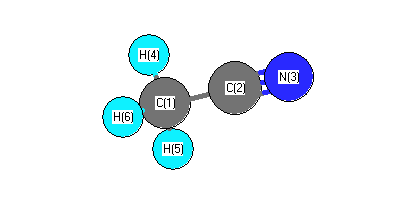Vibrational Frequencies calculated at B3LYPultrafine/daug-cc-pVDZ
| Mode Number |
Symmetry |
Frequency
(cm-1) |
Scaled Frequency
(cm-1) |
IR Intensities
(km mol-1) |
Raman Act
(Å4/u) |
Dep P |
Dep U |
|---|
| 1 |
A1 |
3046 |
3046 |
3.50 |
198.33 |
0.00 |
0.01 |
| 2 |
A1 |
2354 |
2354 |
10.32 |
81.64 |
0.14 |
0.25 |
| 3 |
A1 |
1379 |
1379 |
1.63 |
6.24 |
0.40 |
0.57 |
| 4 |
A1 |
931 |
931 |
1.46 |
5.64 |
0.05 |
0.10 |
| 5 |
E |
3125 |
3125 |
1.05 |
59.80 |
0.75 |
0.86 |
| 5 |
E |
3125 |
3125 |
1.05 |
59.73 |
0.75 |
0.86 |
| 6 |
E |
1444 |
1444 |
10.52 |
5.42 |
0.75 |
0.86 |
| 6 |
E |
1444 |
1444 |
10.52 |
5.46 |
0.75 |
0.86 |
| 7 |
E |
1043 |
1043 |
1.73 |
0.07 |
0.75 |
0.86 |
| 7 |
E |
1043 |
1043 |
1.73 |
0.08 |
0.75 |
0.86 |
| 8 |
E |
371 |
371 |
0.49 |
1.39 |
0.75 |
0.86 |
| 8 |
E |
371 |
371 |
0.49 |
1.39 |
0.75 |
0.86 |
Unscaled Zero Point Vibrational Energy (zpe) 9837.2 cm
-1
Scaled (by 1) Zero Point Vibrational Energy (zpe) 9837.2 cm
-1
See section
III.C.1 List or set vibrational scaling factors
to change the scale factors used here.
See section
III.C.2
Calculate a vibrational scaling factor for a given set of molecules
to determine the least squares best scaling factor.
Charges, Dipole, Quadrupole and Polarizability
Charges from optimized geometry at B3LYPultrafine/daug-cc-pVDZ
Charges (e)
| Number |
Element |
Mulliken |
CHELPG |
AIM |
ESP |
| 1 |
C |
0.991 |
|
|
|
| 2 |
C |
0.048 |
|
|
|
| 3 |
N |
-0.226 |
|
|
|
| 4 |
H |
-0.271 |
|
|
|
| 5 |
H |
-0.271 |
|
|
|
| 6 |
H |
-0.271 |
|
|
|
Electric dipole moments
Electric dipole components in Debye
(What's a Debye? See section
VII.A.3)
| |
x |
y |
z |
Total |
| |
0.000 |
0.000 |
-4.051 |
4.051 |
| CHELPG |
|
|
|
|
| AIM |
|
|
|
|
| ESP |
|
|
|
|
Electric Quadrupole moment
Quadrupole components in D Å
| Primitive |
|---|
| | x | y | z |
|---|
| x |
-17.812 |
0.000 |
0.000 |
| y |
0.000 |
-17.812 |
0.000 |
| z |
0.000 |
0.000 |
-21.091 |
|
| Traceless |
|---|
| | x | y | z |
|---|
| x |
1.640 |
0.000 |
0.000 |
| y |
0.000 |
1.640 |
0.000 |
| z |
0.000 |
0.000 |
-3.280 |
|
| Polar |
|---|
| 3z2-r2 | -6.559 |
|---|
| x2-y2 | 0.000 |
|---|
| xy | 0.000 |
|---|
| xz | 0.000 |
|---|
| yz | 0.000 |
|---|
|
Polarizabilities
Components of the polarizability tensor.
Units are
Å
3 (Angstrom cubed)
Change units.
| |
x |
y |
z |
| x |
3.695 |
0.000 |
0.000 |
| y |
0.000 |
3.695 |
0.000 |
| z |
0.000 |
0.000 |
6.077 |
<r2> (average value of r
2) Å
2
| <r2> |
45.645 |
| (<r2>)1/2 |
6.756 |
